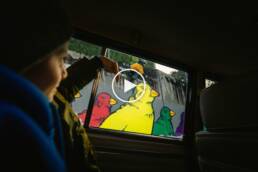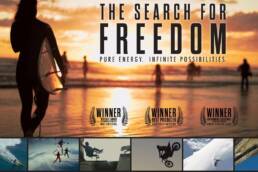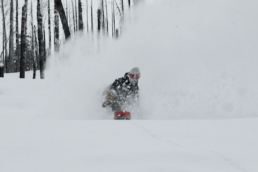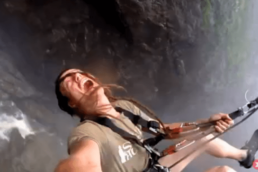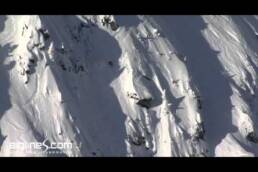From Nike’s Uncle Drew to Jerry of the Day, the video short is a beacon of lucrative metrics in the internet’s marketing landscape. In that competitive market is a BC-based media house heralded for creating one of mountain culture’s most successful cinematic shorts. Now they’re trying to outdo, and out-view, in an effort to fulfill the last inspirations of a dear departed friend. Words By Mitchell Scott. Photos by Jake Dyson.
The wind cuts straight to the bone. It could not give two shits about our PrimaLoft® GORE-TEX® or long underwear. It just rips through it all with a quirky, edge-of-the-continent benevolence. Canada’s most eastern province, Newfoundland and Labrador, is starkly beautiful, but on a grey, mid-February, wind-blown day, not so comfortable. We’re standing in what’s known as the Battery, a small collection of pastel-painted homes affectionately called ‘Jellybean Row’, at the edge of the capital city St. John’s harbor. Eighty kilometre per hour winds scream in from the North Atlantic. At -13 C, it’s the definition of cold. I just want to get back in the car. So does Dave.
Sherpas Cinema director Dave Mossop and I are location scouting. You’re right to guess it’s not for a sun screen commercial. Mossop is the visionary behind the now famous JP Auclair street skiing segment from the movie All.I.Can, a film shot entirely in the West Kootenay cities of Trail, Nelson and Rossland, wants to make a sequel to the segment. For reasons of geographical grandeur, he wants to do it here, through the declivitous streets of downtown St. John’s. The city sees an average of 335 centimetres of snow every winter, is quaint and charming, with a litany of steep streets, rails and stair sets, everything you need for a great urban ski segment.
But that wind. “A seal would lose her pups out here,” quips our location manager, back inside her idling Volvo, she herself wearing a sealskin jacket and matching hat. In the three days of scouting, the weather goes from -13 C and blowing sideways, to -6 C and 25 centimetres of fresh snow—blowing the other sideways, to +8 C and raining upside down.
We leave Newfoundland feeling nervous and excited. If we pull it off, the piece has major potential. If we don’t, well, we might soon learn why no one has done a high-profile, ski segment in St. John’s before.
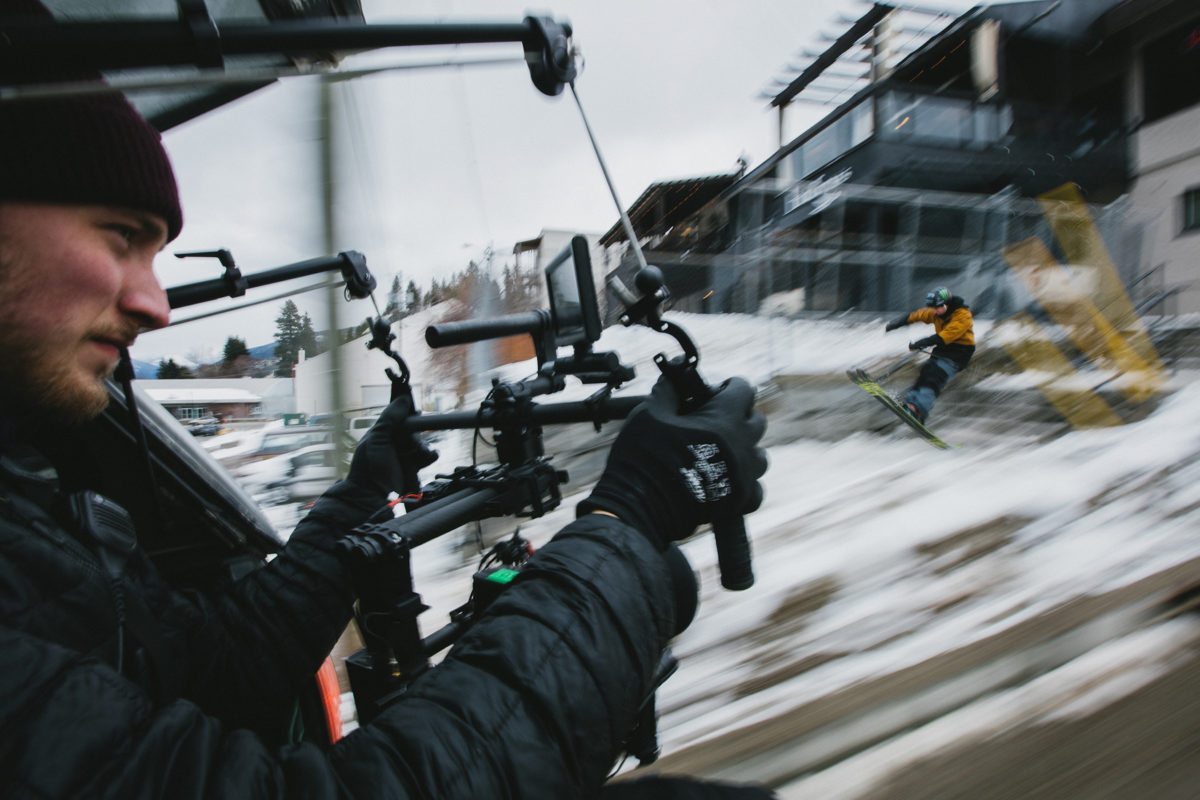
THE WORLD OF THE INTERNET VIDEO SHORT is a gladiator pit. Views being the metaphorical kills. And views are the metrics the purse string holders, titled as marketing directors or executive producers, Not so long ago—even four or five years—all you needed was an original idea and good execution. The landscape was relatively unoccupied. Today, however, the game is entirely different. Thousands of sport oriented videos are uploaded every month—everything from genius Nike commercials featuring famous athletes, through to Jerry of the Day compilations with views well into the tens of millions. YouTube alone sees 300 hours of video uploaded every minute of every day. Standing out not only takes extremely strong creative, but more and more, you need big budgets.
Back in the spring of 2011, when Dave Mossop and JP Auclair filmed their Kootenay street skiing segment, they didn’t have a huge budget, and just the two of them as crew. Regardless, they managed to hit the sweet spot—that perfect confluence of cinematography, story and action. The five-minute piece has well over two million views and, perhaps more that that, serious acclaim as one of the best action sports segments ever filmed.
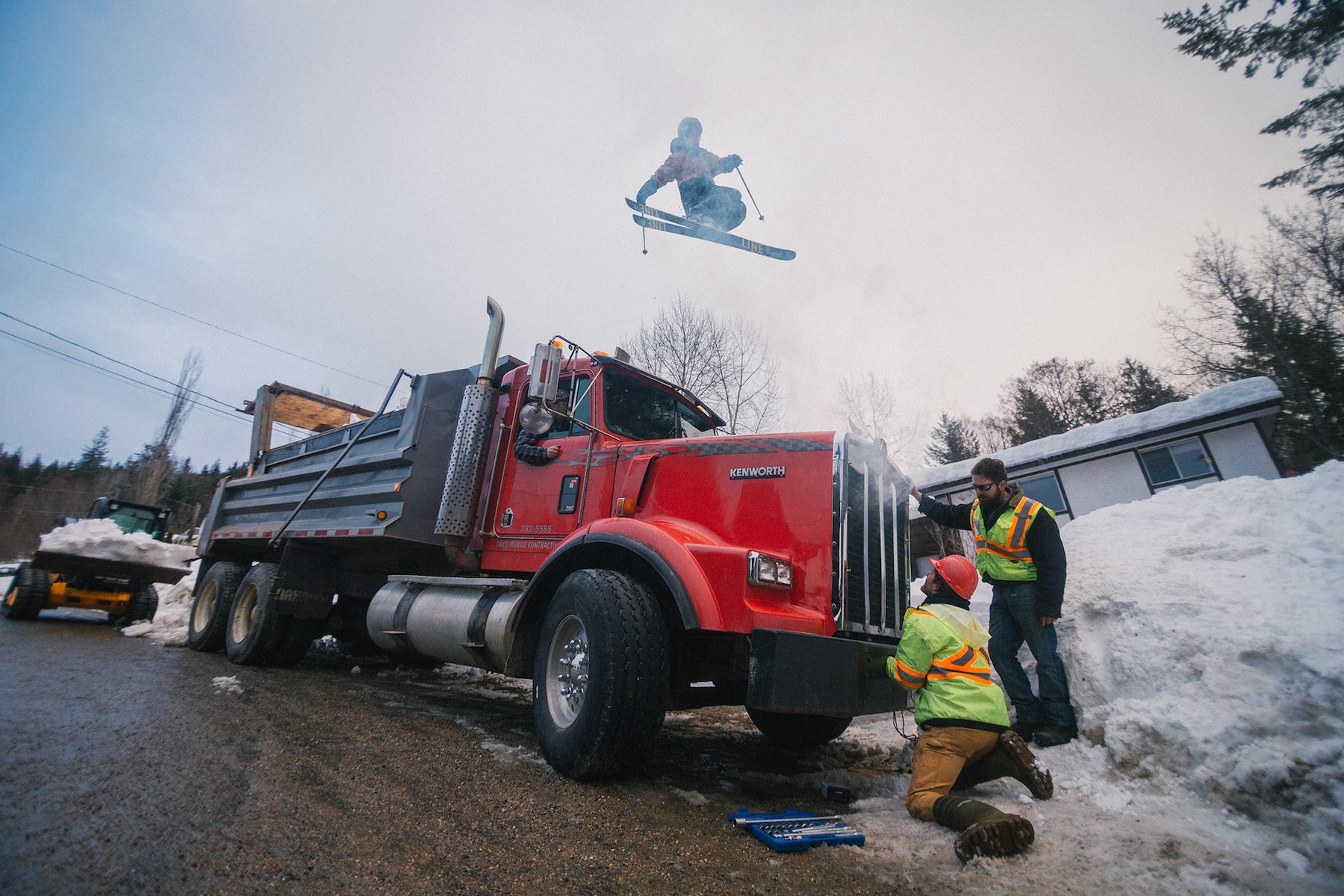
“It was basically just the two of us holed up in a Kootenay hotel for 3 weeks,” explains Mossop, who directed, shot and edited the segment. “We were experimenting with a new idea, one where we edited the segment as we shot it. We had the song and the concept, so during down time we would sit and edit temp placeholder shots on screen. But when it was perfect weather outside (grey and bleak) we went out to shoot those specific shot ideas. Each night we’d get home and drop those shots directly into our timeline, and by the final day we had a pretty decent edit on our hands.”
Sadly, JP Auclair passed away in an avalanche while skiing in Chile in 2014. The loss deeply affected the crew at Sherpas Cinema, who had worked closely with Auclair in the years leading up to his death. He was an innovative and creative skier, and a talented visual artist as well, and before his passing, he shared his idea for the sequel to the Kootenay street segment with Mossop. “What if you shot the whole segment from the perspective of a little kid in the back seat of a car?” Mossop recalls the initial light bulb conversation with Auclair. “What if the kid is pretending to ski with his fingers, like all of us did when we were younger—over cars, and in and out of ditches—and all of a sudden, a skier appears out of nowhere?” The two were jazzed. An idea worthy of its predecessor.
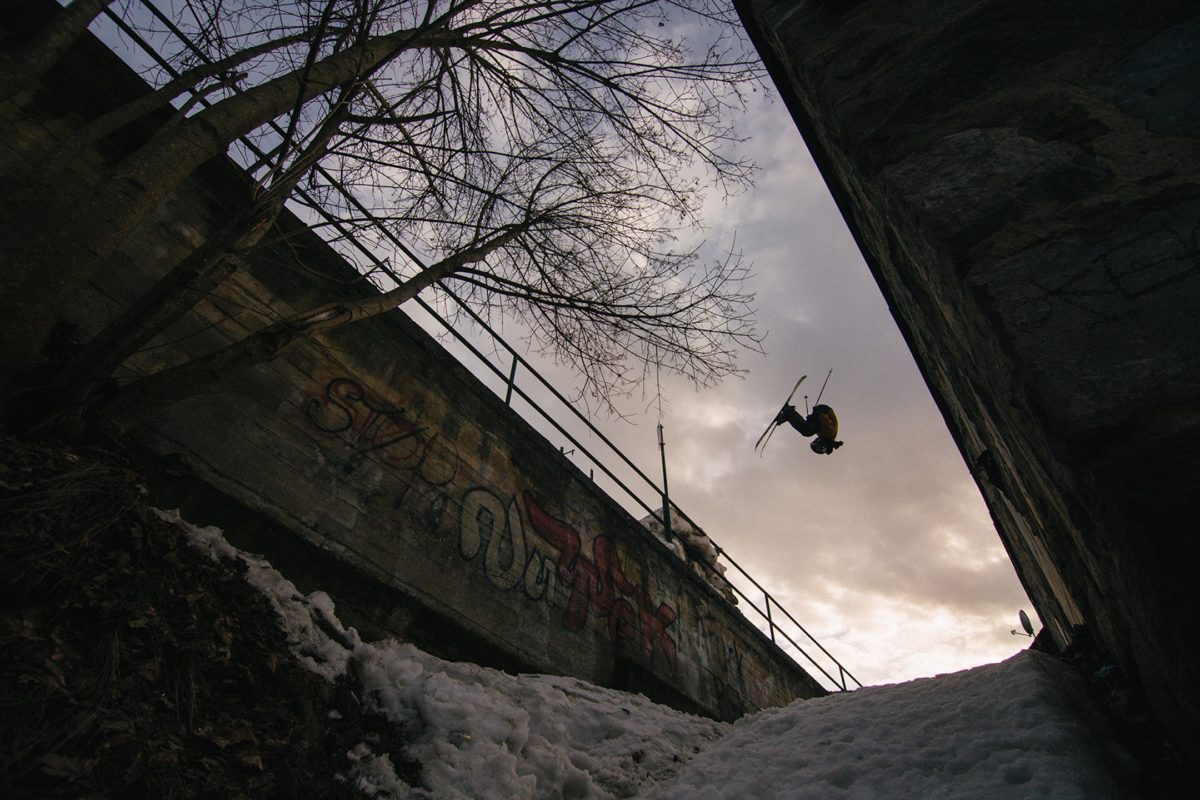
IT’S THE BEGINNING OF MARCH and a crew of 12 cinematographers, producers, directors and athlete Tom Wallisch, a legendary urban skier, are about to embark on the trans-continental journey to St. John’s. As the supervising producer I’m beginning to freak out. Not for my lack of preparation: accommodation is booked, as are the flights, so is the $1,000/day mandatory stunt supervisor, and a slew of other big and small details. There’s a lot on the line creatively and financially.
What has me quivering in me soon-to-be-frozen undies, is the weather. It’s been “spilling rain out” in St. John’s everyday for a week, the city has used the opportunity to remove tons of snow, and our locations manager is sending me grim pictures of small piles of brown, chunks of ice. With no snow in the forecast we’re left with the possibility of cancelling the shoot and saying goodbye to a great idea and the secured six figure North Face budget to make it happen. We’d be lost, freezing seal pups to be sure.
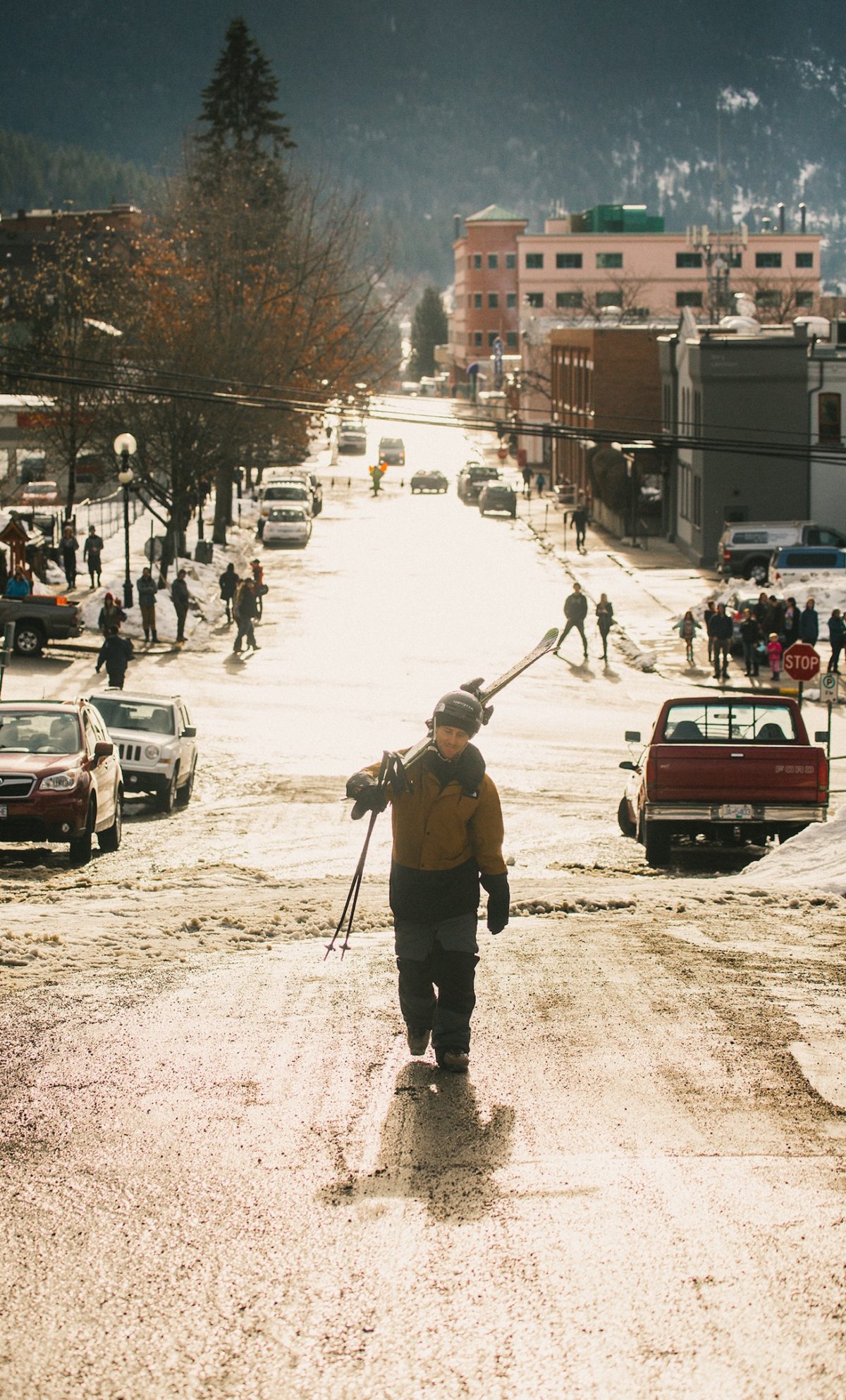
As the whole deal swirls away into the above-zero, sideways-raining ether, I’m struck by the juxtaposition between shots of depressingly snowless streets in St. John’s on my computer, and the view out of my front window in Nelson. I have flashbacks of watching the original Auclair segment, where he jumped clothes lines just a couple blocks from my house in Uphill. In desperation, Mossop asks the crew on the conference call where we could possibly shoot the piece. There’s silence, with murmurs of Whistler or Banff. Too flat. Too perfect. There is only one answer—only one region where residents and lawmakers and public service organizations could possibly approve and get behind an idea like this in one week.
Of course, they’ve seen it before. The Kootenays.
The crew survived epic rain in Ymir, coordinated nearly 100 extras for the finale pull away shot at a Nelson school, convinced residents to let Wallisch jump on and off their roofs (including Ferraro Foods in Rossland), and at one point, were importing snow by the dump truck load as spring began to melt away the in-town canvas of white.
THE NEXT THREE WEEKS ARE A BLUR. Shooting an urban ski segment is a challenge in and of itself. Shooting one from the perspective of a little boy in a moving car adds some intricacy. Tom Wallisch, who holds the world record for the longest rail slide, would be tested by long days and complicated builds, but would pull off a litany of ridiculous stunts, pleasing the many locals who would post up and watch for hours. The segment featured a local cast, which included Sequoia Colbeck, a nine-year-old boy with limited acting experience, and Lucas Meyers and Sydney Black, two well-known actors from Nelson. The piece was titled “Imagination.”
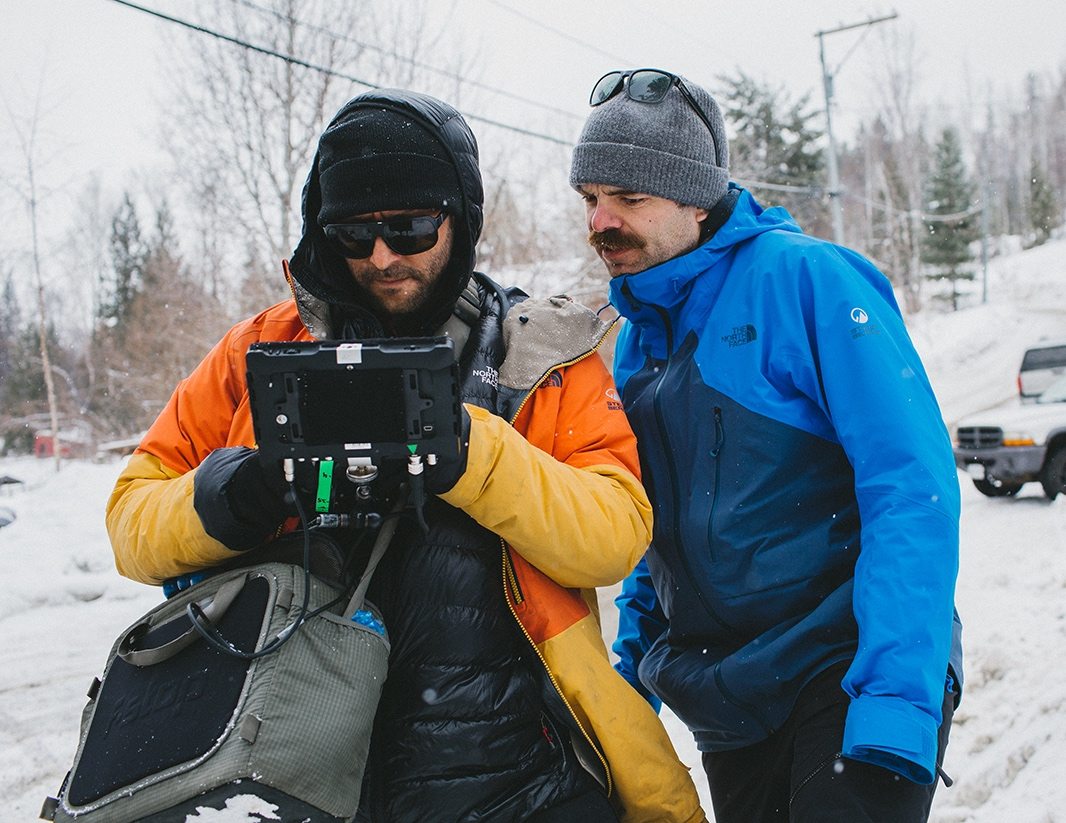
The crew survived monumental rain in Ymir, coordinated nearly 100 extras for the finale pull away shot at a Nelson school, convinced residents to let Wallisch jump on and off their roofs (including Ferraro Foods in Rossland), and at one point, were importing snow by the dump truck load as spring began to melt away the in-town canvas of white.
In keeping with the original line-edit process employed by Mossop and Auclair six years previous, and thanks to the all-hours work of Sherpas’ editor Tim Symes, who was posted up at his edit suite in the basement of Blaylocks Mansion, every day we would see the piece come together, shot-by painstakingly-accrued-shot. The daily review became the critical fire that kept us pressing on. That, and the Woodford’s bourbon.
“What if you shot the whole segment from the perspective of a little kid in the back seat of a car?” Mossop recalls the initial light bulb conversation with Auclair. “What if the kid is pretending to ski with his fingers, like all of us did when we were younger—over cars, and in and out of ditches—and all of a sudden, a skier appears out of nowhere?”
But amongst the wet feet and sore backs, the doing shots over and over and over again until they were just perfect, something quite beautiful happened. The true character of the West Kootenay came to the surface. Everywhere we went we experienced incredible support. From the police and the public works department, to local residents and local businesses. The City of Nelson let us paint a JP tribute mural on a concrete wall in Fairview, they allowed us to shut down major roads during prime business hours, even the Ministry of Transportation bent over backwards to accommodate our needs.
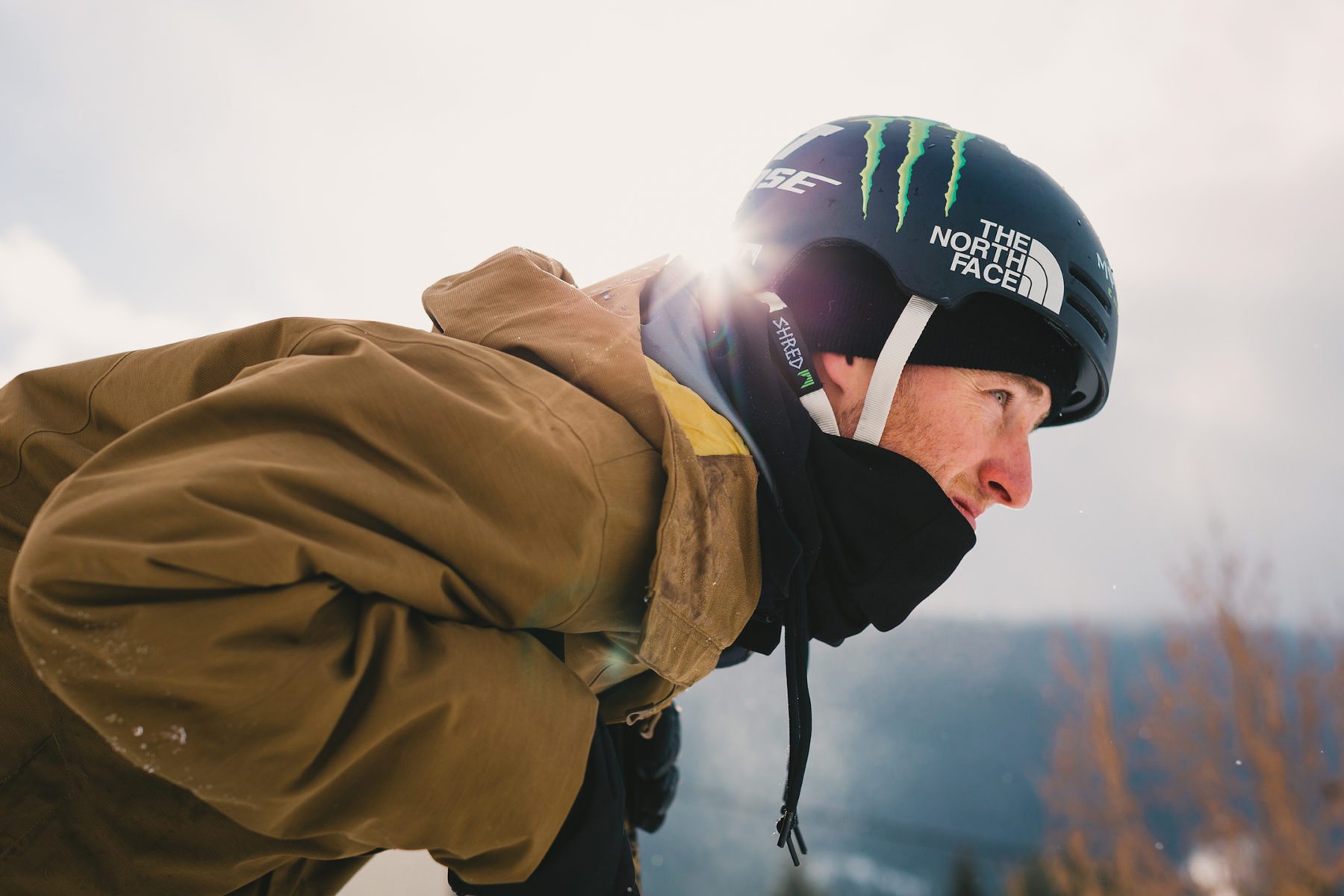
It seemed everyone had seen the original piece. We’d run into people on the street and they knew exactly what we were up to, each one inspired by this new story and the fact we were making a sequel to the original piece. It seemed our project’s maverick craziness (back-flipping driveways and pulling 720s off of carports is not your every-day, in city limits activity) clicked with what the Kootenays are all about. Freedom and art.
“Judging by the biblical weather that St. John’s received during our shoot dates, there is no question that shooting in Nelson was destiny,” continues Mossop. “The people of that community made this piece. In fact, I think it became an expression of Kootenay culture itself: helpful, kind, generous, fun, funny. They all came out of the woodwork to help us dig and clean up, and somehow they all knew of JP Auclair, even the 75-year-olds. It brings a tear to my eye to see firsthand the powerful and wonderful effect that JP left of this community.”
“There’s no way we could have pulled this off anywhere else in the world,” says Tom Wallisch from his home in Park City, Utah. “That place is special. It’s beautiful, for sure, you couldn’t find a more idyllic mountain town setting, but the people man. Wow, they’re special.”
Mitchell Scott
Mitchell Scott is the longtime Editor-in-Chief and co-publisher of both Kootenay Mountain Culture and Coast Mountain Culture Magazines. He's been in the writing/publishing/media business for over 20 years and currently lives in Nelson, BC, where he tries to keep up with his two teenage sons with aching futility.
Related Stories
Cold Rush – Behind the Scenes
Sure, there was a boatload of photographers and cinematographers at the Red Bull Cold Rush. And then there was me, with…
The Search For Freedom: Behind the Scenes
Nelson, British Columbia-based filmmaker Jon Long checks in with a look behind the curtain as he takes us through the…
Behind the Scenes of SilverStar’s Recent Viral Video
The crew at the SilverStar bike park in Vernon, British Columbia, just released a sick vid featuring a downhill…
The Creation of “Regeneration” – A Behind-the-Scenes Interview
This month the movie "Regeneration" drops. We chat with one of its creators about snowboarding, the climate, and, more…
The Craziest Rope Swing in The World
Oh. My. God. This is absolutely terrifying. The look on their faces tells you just how terrifying it must have…
2012 Freeskiing and Freeride World Tour
2012 Freeskiing and Freeride World Tour was in Revelstoke BC on Jan 4-11. Mens Results, -Canadian Kye Petersen took…


